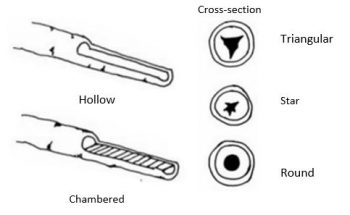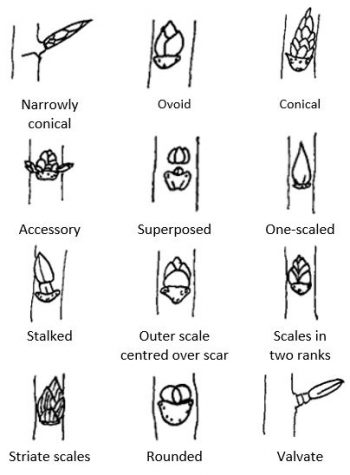20 Plant Growth Characteristics
Learning Objectives
- Recognize and describe plant growth characteristics.
Plant form and growth habit are among the most noticeable and important features for identification purposes as well as for landscape plant selection. Plant form, the three-dimensional shape or silhouette outline of a plant, is determined by the habit or branching pattern. For example, plants with an excurrent growth habit have single, undivided trunks and lateral branches that typically produce an overall cone or pyramid-shaped form. This plant form and growth habit is characteristic of many gymnosperms such as Thuja plicata (western red cedar) and Pseudotsuga menziesii (Douglas fir). In contrast, decurrent, or sometimes called deliquescent growth habit exhibits several roughly equal branches arising from the trunk or stem that become the main structural system of the plant. This habit results in the typical rounded or spreading form of deciduous trees such as Acer macrophyllum (big leaf maple) or Acer platanoides (Norway maple) as well as many shrubs. Depending on the branching pattern, additional descriptive terms such as upright or horizontal, arching or weeping, open, twiggy or dense may be used for shrubs as well as for trees.
Stem, Bark, and Bud Morphology
In addition to plant form and habit, the winter identification of deciduous trees and shrubs depends on the morphology of stems, bark, and buds. Stem color, surface texture and the presence of lenticels, small cork-like spots for gas exchange between plant tissues and air are characteristic for some species of Prunus (cherry). A cross section taken through a stem or shoot reveals soft plant tissue, the pith. The color and texture of the pith may be used for distinguishing between similar plant types, such as species of Cornus (dogwood). Pith may be brown or white, variably shaped, and uniformly solid, chambered or hollow as illustrated in Figure 20.1.

Bark, the dead outer protective tissue of woody plants can vary greatly in appearance, thickness, and texture as a tree or shrub matures. In addition to plant identification, plant bark may have highly ornamental value in the landscape. Color change, peeling and exfoliation, and smooth, or furrowed (grooved), ridged or plate-like are some common descriptors used for bark. For example, Figure 20.2 shows the bark of Platanus × acerifolia[New Tab] . In addition to its ornamental value, the bark is a key identification feature for this tree.

Buds, condensed shoots containing a new leaf, leaf cluster, or flower are located in leaf axils and at tips of stems. In general, a flower bud appears somewhat larger and rounder than a vegetative bud. While bud shape, size, color, and surface texture vary by species, bud arrangement will be alternate, opposite or whorled on the stem. Bud scales, the protective covering of buds may be single, few, or many, and imbricated (overlapping) or not as shown in the Figure 20.3. The shape of a leaf scar, where a leaf falls off a twig, and the arrangement of vascular bundles within the leaf scar may also provide distinct identification characteristics as in Juglans spp. (walnut).

The dichotomous key below differentiates bud characteristics for some common deciduous trees and shrubs. Plant information is available at the KPU Plant Database [New Tab].
Dichotomous Key to Buds of Common Deciduous Trees and Shrubs
- 1.a. buds opposite or whorled on the stem ……………………………………………………. go to 2
- 1.b. buds not opposite on the stems ……………………………………………………………… go to 7
- 2.a. leaf scars oval or round, vein scars forming a ring ……………………. Catalpa speciosa [New Tab]
- 2.b. leaf and vein scars not as above ……………………………………………………………… go to 3
- 3.a. buds valvate, appressed, brownish black ………………… Cornus kousa var. chinensis [New Tab]
- 3.b. buds acute or swollen, red or green ……………………………………………………….. go to 4
- 4.a. buds small or narrow, with few obvious scales, the scales more or less valvate (i.e., meeting at the edges) …………………………………………………………………………….. go to 5
- 4.b. buds large, with several imbricate (overlapping) scales ………………………….. go to 6
- 5.a. buds conical, the outer scales shiny red, the bud with a short fringe of hairs at its base…………………………………………………………………………………………………. Acer circinatum [New Tab]
- 5.b. buds conical, the outer bud scales green or red, hairs extending half the height of the bud…………………………………………………….. Acer palmatum Atropurpureum Group [New Tab]
- 6.a. buds brown large, ovoid, and varnished with sticky gum ……………………………………………………………………………………………. Aesculus hippocastanum [New Tab]
- 6.b. buds smooth, leaf scars small, with a single vein scar………………… Syringa vulgaris [New Tab]
- 7.a. buds narrowly conical and bud scales imbricate ………………………… Fagus sylvatica [New Tab]
- 7.b. the bud scales imbricate or valvate, or the buds covered by a single scale …………………………………………………………………………………………………………………….. go to 8
- 8.a. buds stalked ……………………………………………………………………………………. Alnus rubra [New Tab]
- 8.b. buds not stalked ……………………………………………………………………………………. go to 9
- 9.a. twigs yellow, the buds flattened, appressed to stems and covered by a single, silky-downy bud scale…………………………………………… Salix sepulcralis var. chrysochoma [New Tab]
- 9.b. twigs not yellow, buds not covered by a single scale ……………………………. go to 10
- 10.a. lateral buds superposed, slightly hairy; leaf scars v-shaped, prominent; pith chambered ………………………………………………………………………………………….. Juglans nigra [New Tab]
- 10.b. buds not superposed; leaf scars not v-shaped; pith not chambered …………………………………………………………………………………………………………………… go to 11
- 11.a. buds 2 mm long, rounded to shortly acute, with several reddish-brown scales ……………………………………………………………………………………………………… Cotinus coggygria [New Tab]
- 11.b. buds 2 mm long, ovoid to acute, with several rows of imbricate scales …………………………………………………………………………………………………………………… go to 12
- 12.a. buds of 2 sizes, bud scales glabrous, leaf scars triangular with 3 vein scars ……………………………………………………………………………………………………….. Prunus ‘Kanzan’ [New Tab].
- 12.b. buds of 1 kind; buds scales fringed with hair; leaf scars with 5 or more vein scars …………………………………………………………………………………………………. Quercus robur [New Tab]

